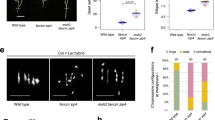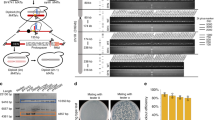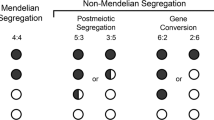Abstract
GENETIC recombination involves classical crossing-over and gene conversion (aberrant segregation). In fungi that produce an ascus containing four spores, a gene conversion event is manifested as 3:1 or 1:3 (or more rarely 4:0 or 0:4) segregations, in contrast to the normal mendelian 2:2 segregation1,2. Polarity is one of the properties of gene conversion; in almost all cases the frequency of conversion exhibits a gradient across the gene monitored1. The frequency of conversion is usually independent of the specific allele used as a marker, but dependent on its location. An interpretation of conversion polarity is that it is caused by the existence of specific initiation sites for meiotic recombination, located at the high end of the polarity gradient. Here we show that the polarity gradient for the HIS2 gene of Saccharomyces cerevisiae is high at the 3′ end of the gene, implying that the promoter of HIS2 is not the initiation site.
This is a preview of subscription content, access via your institution
Access options
Subscribe to this journal
Receive 51 print issues and online access
$199.00 per year
only $3.90 per issue
Buy this article
- Purchase on Springer Link
- Instant access to full article PDF
Prices may be subject to local taxes which are calculated during checkout
Similar content being viewed by others
References
Fogel, S., Mortimer, R., Lusnak, K. & Tavares, F. Cold Spring Harb. Symp. quant. Biol. 43, 1325–1341 (1979).
Petes, T., Malone, R. E. & Symington, L. in The Molecular Biology of the Yeast Saccharomyces (eds Broach, J., Pringle, J. & Jones, E.) 407–522 (Cold Spring Harbor Laboratory, New York, 1991).
Nicolas, A., Treco, D., Schultes, N. P. & Szostak, J. W. Nature 338, 35–39 (1989).
Schultes, N. P. & Szostak, J. W. Genetics 126, 813–822 (1990).
White, M. A., Wierdl, M., Detloff, P. & Petes, T. D. Proc. natn. Acad. Sci. U.S.A. 88, 9755–9759 (1991).
Schultes, N. P. & Szostak, J. W. Molec. cell. Biol. 11, 322–328 (1991).
White, M., Detloff, P., Strand, M. & Petes, T. D. Curr. Genet. 21, 109–116 (1992).
Schultes, N. P. & Szostak, J. W. Genetics 126, 813–822 (1990).
DiCaprio, L. & Hastings, P. J. Genetics 84, 697–721 (1976).
Rothstein, R. Meth. Enzym. 194, 281–301 (1991).
Scherer, S. & Davis, R. W. Proc. natn. Acad. Sci. U.S.A. 76, 4951–4955 (1979).
Struhl, D. Proc. natn. Acad. Sci. U.S.A. 82, 8419–8423 (1985).
Author information
Authors and Affiliations
Rights and permissions
About this article
Cite this article
Malone, R., Bullard, S., Lundquist, S. et al. A meiotic gene conversion gradient opposite to the direction of transcription. Nature 359, 154–155 (1992). https://doi.org/10.1038/359154a0
Received:
Accepted:
Issue Date:
DOI: https://doi.org/10.1038/359154a0
This article is cited by
-
Genetic and physiological alterations occurring in a yeast population continuously propagated at increasing temperatures with cell recycling
World Journal of Microbiology and Biotechnology (2007)
-
A test of the CoHR motif associated with meiotic double‐strand breaks in Saccharomyces cerevisiae
EMBO reports (2004)
-
Patterns of meiotic double-strand breakage on native and artificial yeast chromosomes
Chromosoma (1996)
-
Polarity of meiotic gene conversion is 5′ to 3′ within the niaD gene of Aspergillus nidulans
Molecular and General Genetics MGG (1995)
-
Polarity of meiotic gene conversion in fungi: Contrasting views
Experientia (1994)
Comments
By submitting a comment you agree to abide by our Terms and Community Guidelines. If you find something abusive or that does not comply with our terms or guidelines please flag it as inappropriate.



